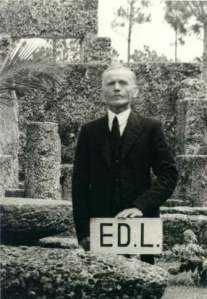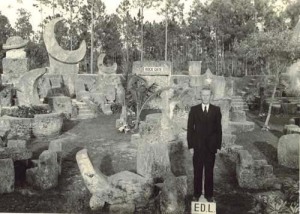
Recently, I came upon a YouTube clip that felt like uncovering a childhood book at the bottom of an old box. One you don’t remember at all until you see its cracked cover and then every illustration, every odd turn-of-phrase, comes rushing back.
In this case, it was documentary segment dedicated to a miraculous structure called the Coral Castle. Located about 30 miles south of Miami in Homestead, Florida, it is one of those odd buildings—Mystery Castle in Phoenix and Winchester Mystery House in San José are others—that are the result of one “ordinary” person’s eccentric quest to create something extraordinary.
Coral Castle is the improbable—impossible?—product of one man: Edward Leedskalnin, a 5-ft. tall, 100-lb. Latvian immigrant who cut, quarried, transported (ten miles), and raised the entire structure, which consists of more than 1,100 tons of coral rock, alone.
 While, in that part of Florida, coral can be 4,000 feet thick, Leedskalnin reportedly used only hand-made tools, with no large machinery and no workers assisting him. Among much of the disbelieving press about the Castle—particularly during its early years—much nasty head-shaking was made not just over the fact that one man could build something like this, but that an “illiterate immigrant” could. According to the Castle’s official website:
While, in that part of Florida, coral can be 4,000 feet thick, Leedskalnin reportedly used only hand-made tools, with no large machinery and no workers assisting him. Among much of the disbelieving press about the Castle—particularly during its early years—much nasty head-shaking was made not just over the fact that one man could build something like this, but that an “illiterate immigrant” could. According to the Castle’s official website:
When questioned about how he moved the blocks of coral, Ed would only reply that he understood the laws of weight and leverage well. This man with only a fourth grade education even built an AC current generator, the remains of which are on display today. Because there are no records from witnesses his methods continue to baffle engineers and scientists, and Ed’s secrets of construction have often been compared toStonehengeand the great pyramids.
At a certain point during its long construction point, Leedskalnin opened his monument to the public, offering tours for 10 cents. Apparently, he even served up hot dogs for visiting children, the product of a pressure cooker he had invented.
The work of the Castle absorbed him from 1920 until his death in 1951.
 The best part of the story, though (for me), is not the triumph of one dedicated (obsessive) man to overcome expectation, engineering, and our conceptions of what’s possible (though that’s pretty good too). It’s the reason why Mr. Leedskalnin built the castle to begin with. I bet you know why.
The best part of the story, though (for me), is not the triumph of one dedicated (obsessive) man to overcome expectation, engineering, and our conceptions of what’s possible (though that’s pretty good too). It’s the reason why Mr. Leedskalnin built the castle to begin with. I bet you know why.
Like an “everyman” Charles Foster Kane building his Xanadu for his beloved. In this case a woman Leedskalnin referred to as his “Sweet Sixteen,” a young woman with the Dickensian name of Agnes Scuffs. At age 26, Leedskalnin was engaged to Miss Scuffs, ten years his junior, but, legend has it, she broke off the relationship on the eve of their wedding.
A fascinating (and to my mind, quintessentially American) figure, Leedskalnin was not just a sculptor, he was an inventor, a theorist on the properties of magnetism and a writer, the author of five “pamphlets.” Three are dedicated to “Magnetic Current” and one to “Mineral, Vegetable and Animal Life” The fifth is called A Book in Every Home: Containing Three Subjects: Ed’s Sweet Sixteen, Domestic and Political Views. In it, Leedskalnin writes about “Sweet Sixteen” as more than a single Agnes Scruffs but a symbol for the kind:
Now, I am going to tell you what I mean when I say, “Ed’s Sweet Sixteen.” I don’t mean a sixteen year old girl; I mean a brand new one.
Later, he writes:
…I want a girl the way Mother Nature puts her out. This means before anybody has had any chance to be around her and before she begins to misrepresent herself. I want to pick out the girl while she if guided by the instinct alone
And he expand to larger social views:
Everything we do should be for some good purpose but as everybody knows there is nothing good that can come to a girl from a fresh boy. When a girl is sixteen or seventeen years old, she is as good as she ever will be, but when a boy is sixteen years old, he is then fresher than in all his stages of development. He is then not big enough to work but he is too big to be kept in a nursery and then to allow such a fresh thing to soil a girl—it could not work on my girl. Now I will tell you about soiling. Anything that is done, if it is done with the right party it is all right, but when it is done with the wrong party, it is soiling, and concerning those fresh boys with the girls, it is wrong every time.
Indeed, Mr. Leedskalnin. Indeed.
(I do not remember any of these details of the story from when I first became fascinated by the castle—which I’ve yet to see!—at age eight or so. I’m sure, however, that, at that age, I would have taken due note.)
 Mr. Leedskalnin never married. While he extended invitations to Agnes Scuffs over the years, she never did see the monument he built for her.
Mr. Leedskalnin never married. While he extended invitations to Agnes Scuffs over the years, she never did see the monument he built for her.
Postscript: I am sure there are folks out there who know much more than I do about Coral Castle (Dennis, help me!), or who have visited it. If so, tell me more!



